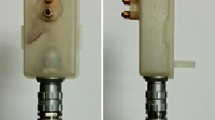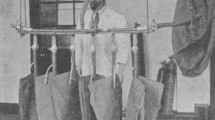Abstract
Outpatient measurements of oxygen consumption (VO2) and cardiac output (CO) are valuable in the management of pediatric cardiac disease. Current methods are inaccurate and cumbersome or require invasive procedures. New devices to measure these variables in adults have not been rigorously tested for children. The Innocor system uses a photoacoustic analyzer to measure gas content for noninvasive measurement of VO2 and CO. This study sought to validate Innocor-derived VO2 measurements in children and adults by comparing them against the gold standard Douglas bag method. Subjects were tested in an outpatient setting. Adaptations were made for pediatric patients based on weight. Resting VO2 measurements were obtained simultaneously by the Innocor system and Douglas bag during 3 min. The study enrolled 31 children (mean age, 12.2 years; range, 7–17 years, 17 girls) and 29 adults (mean age, 36.7 years; range, 19–57 years; 17 women). Strong correlation between the two techniques was seen for both the adults (R 2 = 0.88) and the children (R 2 = 0.82). The average discrepancy between the Innocor and Douglas bag measurements was 1.7 % (range, 0.6–19.1 %) for the adults, and 5.4 % (range, 0.1–32.2 %) for the children. The discrepancy was more than 15 % for 17 % of the adults and 22 % of the children, with the Innocor device tending to overestimate VO2 in children compared with the Douglas bag. This trend was not seen in adults. The Innocor system has excellent correlation with the Douglas bag and shows promise for noninvasive measurement of VO2 and CO in the school-age pediatric population.



Similar content being viewed by others
References
Agostoni P, Cattadori G (2009) Noninvasive cardiac output measurement: a new tool in heart failure. Cardiology 114:244–246
Bland JM, Altman DG (1986) Statistical methods for assessing agreement between two methods of clinical measurement. Lancet 1:307–310
Bonfils PK et al (2010) Impact of diuretic treatment and sodium intake on plasma volume in patients with compensated systolic heart failure. Eur J Heart Fail 12:995–1001
Chew MS, Poelaert J (2003) Accuracy and repeatability of pediatric cardiac output measurement using Doppler: 20-year review of the literature. Intensive Care Med 29:1889–1894
Chua TP et al (1997) Clinical correlates and prognostic significance of the ventilatory response to exercise in chronic heart failure. J Am Coll Cardiol 29:1585–1590
Critchley LA, Critchley JA (1999) A meta-analysis of studies using bias and precision statistics to compare cardiac output measurement techniques. J Clin Monit Comput 15:85–91
Dong L et al (2005) Validation of the use of foreign gas rebreathing method for non-invasive determination of cardiac output in heart disease patients. J Zhejiang Univ Sci B 6:1157–1162
Fakler U et al (2005) Assumed oxygen consumption frequently results in large errors in the determination of cardiac output. J Thorac Cardiovasc Surg 130:272–276
Gabrielsen A et al (2002) Noninvasive measurement of cardiac output in heart failure patients using a new foreign gas rebreathing technique. Clin Sci (Lond) 102:247–252
Goda A et al (2009) Usefulness of noninvasive measurement of cardiac output during submaximal exercise to predict outcome in patients with chronic heart failure. Am J Cardiol 104:1556–1560
Horsley AR et al (2007) Lung clearance index is a sensitive, repeatable, and practical measure of airways disease in adults with cystic fibrosis. Thorax 63:135–140
Lang CC et al (2007) Ease of noninvasive measurement of cardiac output coupled with peak VO2 determination at rest and during exercise in patients with heart failure. Am J Cardiol 99:404–405
Li J (2012) Accurate measurement of oxygen consumption in children undergoing cardiac catheterization. Catheter Cardiovasc Interv. doi:10.1002/ccd.24440
Lund LH et al (2005) Validation of peak exercise oxygen consumption and the heart failure survival score for serial risk stratification in advanced heart failure. Am J Cardiol 95:734–741
Mancini D et al (1991) Value of peak exercise oxygen consumption for optimal timing of cardiac transplantation in ambulatory patients with heart failure. Circulation 83:778–786
Mohsenifar Z et al (1988) Relationship between oxygen uptake and oxygen delivery in patients with pulmonary hypertension. Am J Respir Crit Care Med 138:69–73
Robinson BW et al (1993) Selective pulmonary and systemic vasodilator effects of amrinone in children: new therapeutic implications. J Am Coll Cardiol 21:1461–1465
Rogers D, Olson B (1995) Scaling for the VO2-to-body size relationship among children and adults. J Appl Physiol 79(3):958–967
Saur J et al (2009) Noninvasive determination of cardiac output by the inert-gas-rebreathing method: comparison with cardiovascular magnetic resonance imaging. Cardiology 114:247–254
Wiegand G et al (2010) Noninvasive cardiac output determination for children by the inert gas-rebreathing method. Pediatr Cardiol 31:1214–1218
Wolf A et al (1998) Use of assumed versus measured oxygen consumption for the determination of cardiac output using the Fick principle. Cathet Cardiovasc Diagn 43:372–380
Acknowledgments
The project described in this report was supported by the Stanford NIH/NCRR CTSA award number UL1 RR025744 and by the Lucile Packard Foundation for Children’s Health. The authors thank Knud Pedersen at Innovision, Denmark, for his technical support throughout this project.
Author information
Authors and Affiliations
Corresponding author
Rights and permissions
About this article
Cite this article
Sheth, S.S., Maxey, D.M., Drain, A.E. et al. Validation of the Innocor Device for Noninvasive Measurement of Oxygen Consumption in Children and Adults. Pediatr Cardiol 34, 847–852 (2013). https://doi.org/10.1007/s00246-012-0555-6
Received:
Accepted:
Published:
Issue Date:
DOI: https://doi.org/10.1007/s00246-012-0555-6




